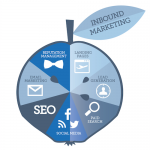Revenue Generation: Facilitating the Buyers’ Journey – Part 3
 Download this series of posts as an ebook.
Download this series of posts as an ebook.
Companies lie or at least they promise way more than they can deliver. Do you trust advertisements? Do you believe what companies say about themselves and their products/services?
I don’t, you don’t and your potential customers don’t.
In an era where the price of communication has dropped the volume of propaganda has increased correspondingly. Our customers are more careful than ever when they venture to find solutions for their needs, challenges and opportunities.
At the same time our industry is constantly developing improvements and inventing completely new value propositions that our customers can benefit greatly from if they only knew about them.
Read Part 1
Read Part 2
Read Part 4
Read Part 5
Now let’s take a look at each step in the buyer’s journey.
I trust them
How do you build trust with the vast majority of your market that is a long way away from being in buying mode?
Let me tell you what doesn’t build trust:
- Pushing yourself, your products, your services and your company (this is propaganda).
- Producing customer testimonials that are too polished and orchestrated.
- Posting pictures on social media from your internal meetings (see how cool we are) or showing how cool your offices are (leave that to the HR folks – that’s their job).
- Making a product or company announcement (including that you have raised a new round of funding).
- Designing your LinkedIn profile with the objective of getting another job (which 99% of all sales and marketing people do).
- Posting, sharing and liking posts on social media that are completely unrelated to your customers’ issues.
- Not communicating at all.
Then what does build trust?
- Offering material (books, whitepapers, videos, articles, pod casts etc.) that demonstrate your insight and engagement with your potential customers’ issues.
- Posting, sharing, commenting and liking posts on social media related to your potential customers’ issues.
- Announcing that you are now included in Gartner’s Magic Quadrant.
- Being found and offering valuable content that your potential customers can use for inspiration to deal with the issues they have.
- A long list of testimonials loaded with the keywords used by your potential customers.
Reaching out to potential customers with content that focuses on their issues without any hint of propaganda builds trust.
You must provide value and continue to provide value until your potential customers find you so interesting that they decide to follow you.
I follow them
 Not all your potential customers will follow you, but some of those who find you a trusted source may do so. They may follow you or your company on LinkedIn, on Twitter and other social media platforms. They may add your web site to their RSS feeder. They may bookmark your blog for later reference. There are many different ways your potential customers may follow you. Make it easy for them and make sure you stay relevant or they will quickly drift off.
Not all your potential customers will follow you, but some of those who find you a trusted source may do so. They may follow you or your company on LinkedIn, on Twitter and other social media platforms. They may add your web site to their RSS feeder. They may bookmark your blog for later reference. There are many different ways your potential customers may follow you. Make it easy for them and make sure you stay relevant or they will quickly drift off.
I engage with them
People who sign up for your newsletter or download a whitepaper from your web site and leave their email address have engaged with you. They become an identified inbound lead, but beware that “all inbound leads are not created equal [1].”
Inbound leads need careful qualifying and most will be of no value, but some may be genuine leads and that by being nurtured and developed can become prospects and then customers sometime in the future.
I may buy from them
At a certain stage a switch will flip in the brains of your potential customers. From knowing who you are they have come to trust you so much that they have started following you. They have engaged with you and received genuine value in return and without being conscious about it they are suddenly in a state of mind that – when the times come – they will put you on the list of potential suppliers.
I evaluate them
And now that time has come. Your potential customer has moved into BANT mode and you are on the list of potential suppliers.
There is an ongoing discussion in marketing and sales about to what extent you as suppliers can instigate a BANT situation. Can you dive into a potential customer and activate the needs for what you do and create enough momentum that a key decision maker will take charge and define a project and find the budget required to make the investment?
When I was the country manager of Data General in Denmark one of our customers used our engineering workstations for designing ships. More than 100 engineers spent 8 hours a day in front of their workstations detailing the maze of oil tankers and container ships. We proposed to continuously test upgrading various modules of a workstation and measure the impact on performance. It would be quite easy to calculate how an impact on workstation performance could be translated into engineering productivity, that again would translate into lower production costs, faster throughput and improved profitability that again could be translated into more orders and more investments. From time to time we did find combinations of upgrades that had a positive impact on performance and when we did the customer immediately ordered an upgrade kit for all 100 workstations.
It is obviously much easier to identify up- and cross sales opportunities with existing customers.
What about new customers?
If your communication approach is propaganda based it will not happen, but if your dialogue with your potential customers is focused on their issues and you are given the opportunity to learn about the specifics of the individual customer situation, then I will claim that you can move the needle.
There will be situations where you will find the combination of needs and people required to make an assessment and prove that doing something now is better than doing it later. I am not saying that you can always do it, but if you invest the time required to fully understand the specific situation and work closely with the people developing the full business case, then your chances will improve substantially. Even when the case doesn’t come to fruition I am certain that you will have built a reputation that will provide you a return on your investment at a later stage.
I buy from them
Even though you may not always be successful moving the needle you will certainly have positioned yourself well. Your work will be reflected in the next requirement specification and you will have built the personal relationship required to navigate the final mile of the purchase process when that day comes. Trying to move the needle is never a complete waste of resources as long as you continuously qualify your opportunities and consciously assess the probability for success. You cannot afford to invest time and effort in anybody showing a pulse, so be very selective.
I recommend them
There is no stronger marketing vehicle than a recommendation from another customer. Anything from just the customer logo to a detailed customer case story has great value and can be used to accelerate the buyer’s journey from unaware to “I may buy.” It will also help you improve your chances in coming out successfully in the last mile of the purchase process, because most customers find great comfort in solid references that resemble themselves.
I buy more from them
 In today’s consumption driven delivery formats [2] the first order you get from a customer may often not cover your customer acquisition cost. You must retain the customer and grow the relationship to reach break-even and secure profitability.
In today’s consumption driven delivery formats [2] the first order you get from a customer may often not cover your customer acquisition cost. You must retain the customer and grow the relationship to reach break-even and secure profitability.
It is easier said than done. It should be as easy as possible to get onboard with you and it should as “difficult” as possible to switch to another supplier. Not because you are proprietary, but because you provide a lot of value to a lot of users. That’s a real challenge, because products that are instantly very easy to use are usually also very easy to drop in favor of a cheaper alternative that is also easy to use.
Making your products and services important for your customers and adding more and more value to more and more users is key to keeping a growing relationship. We call this “customer success” and many companies now have an army of people assigned to ensure just that.
To be continued
[1] A phrase taken from the book Predictable Prospecting: How to Radically Increase Your B2B Sales Pipeline, by Marylou Tyler and Jeremey Donovan. McGraw-Hill Education; 1 edition (August 15, 2016)
[2] Subscription based delivery formats where customers can start with a few users and few modules and then expand gradually as required.
–ooOoo–
 You may also be interested in reading the whitepaper “Social Selling without Situational and Contextual Content is like Partying with Robots”
You may also be interested in reading the whitepaper “Social Selling without Situational and Contextual Content is like Partying with Robots”
The whitepaper defines the three types of content and explains how you decide when to provide your potential customers which each type. It then introduces the concept of marketing and sales as the facilitation of the buyer’s journey and explains that the nature of your business model determines to which degree you can take advantage of social media.
The whitepaper recommends how to build the basic foundation for using social media for sales purposes and concludes that it must be an integrated and managed part of your marketing mix and should not be left entirely to the individual sales person’s own initiative.









